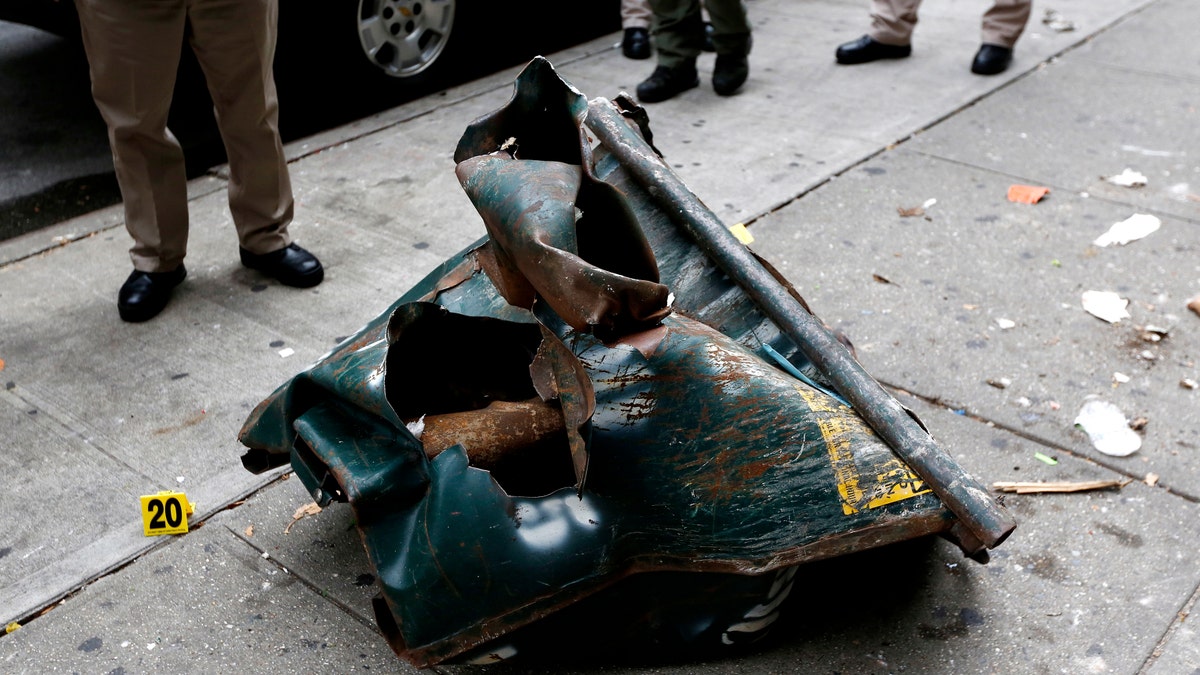
A view of a mangled dumpster at the site of an explosion that occurred on Saturday night in the Chelsea neighborhood of New York, USA, Sept. 18, 2016. (REUTERS/Junstin Lane/Pool)
An alert was sent to smartphones across the New York City area Monday in the hunt for Ahmad Khan Rahami, the suspect in this weekend’s bombings in Manhattan and New Jersey.
The alert, which was sent to phones around 8 a.m. EDT urged anyone with information on Rahami and his whereabouts to contact police. “WANTED: Ahmad Khan Rahami, 28-yr-old male. See media for pic. Call 9-1-1 if seen,” it read.
A loud buzz accompanied the alert.
The suspect was captured after a shootout in Linden, New Jersey later on Monday morning.
Related:
Rahami, a 28-year-old naturalized U.S. citizen, was being sought for questioning regarding the Saturday night blast in New York's Chelsea neighborhood, an explosion in Seaside Park on Saturday morning and a foiled bomb attack Sunday night near a train station in Elizabeth, NJ.
A smartphone alert was also sent out early Sunday to people in the vicinity of a second device in Chelsea that did not detonate.
Alert we received at the site of the second possible explosive device found 6/7 avenues on 27th street. #ChelseaNYC pic.twitter.com/3wEcRUYHQa
— Bryan Llenas (@BryanLlenas) September 18, 2016
Wireless emergency alerts are typically used to provide warnings about extreme weather, and have also been harnessed for Amber alerts when children have been abducted.
Wireless industry association CTIA worked with the Federal Communications Commission and the Federal Emergency Management Agency to develop the Wireless Emergency Alerts (WEA) system.
Mobile users are automatically enrolled to receive the short text-like messages, and are not charged for receiving the alerts. However, the alerts are not text messages, according to CTIA.
“WEA use a different kind of technology to ensure they are delivered immediately and are not subjected to potential congestion (or delays) on wireless networks,” it explains, on its website. “WEA use a point-to-multipoint system, which means alert messages will be sent to those within a targeted area, unlike text messages which are not location aware,” explains the CTIA, on its website. “For example, if a Washington, D.C. resident has a WEA-capable device, but happened to be in an area in southern California when an earthquake occurred, the device would receive an ‘Imminent Threat Alert’.”
The system, which became officially available in April 2012, has already registered some major successes, according to CTIA. The industry group cites, for example, a 2015 Amber alert in the New York City area that saved a 3-year-old from abduction.
New York City Mayor Bill de Blasio praised the emergency alert system during a press conference Monday afternoon. “We activated earlier today a messaging system used by our Office of Emergency Management that allowed us to get information out to all New Yorkers across the board and it had an extraordinary effect,” he said. “That is something that proved to be very helpful in this instance, getting that message out broadly, putting everyone on alert in a mutual way.”
NYPD Commissioner James O’Neill echoed de Blasio’s comments. “The alert system is very helpful to the Police Department and the FBI in this and in other instances, also – it gets everybody involved, it’s that sense of shared responsibility,” he said, during the press conference. “There’s 36,000 of us, a number of FBI agents, but if we can get everybody in the city engaged in helping us keep it safe, I think this the way to go, this is the future.”
Authorities said the New York and New Jersey bombs used flip phones as detonators. Several media outlets also reported the New York bombs contained shrapnel consisting of ball bearings and BBs.
Facebook activated its Safety Check service that lets users notify friends and family that they are safe following the bombing in New York City, the first time that it has been activated in the city.
The Associated Press contributed to this report.
Follow James Rogers on Twitter @jamesjrogers
